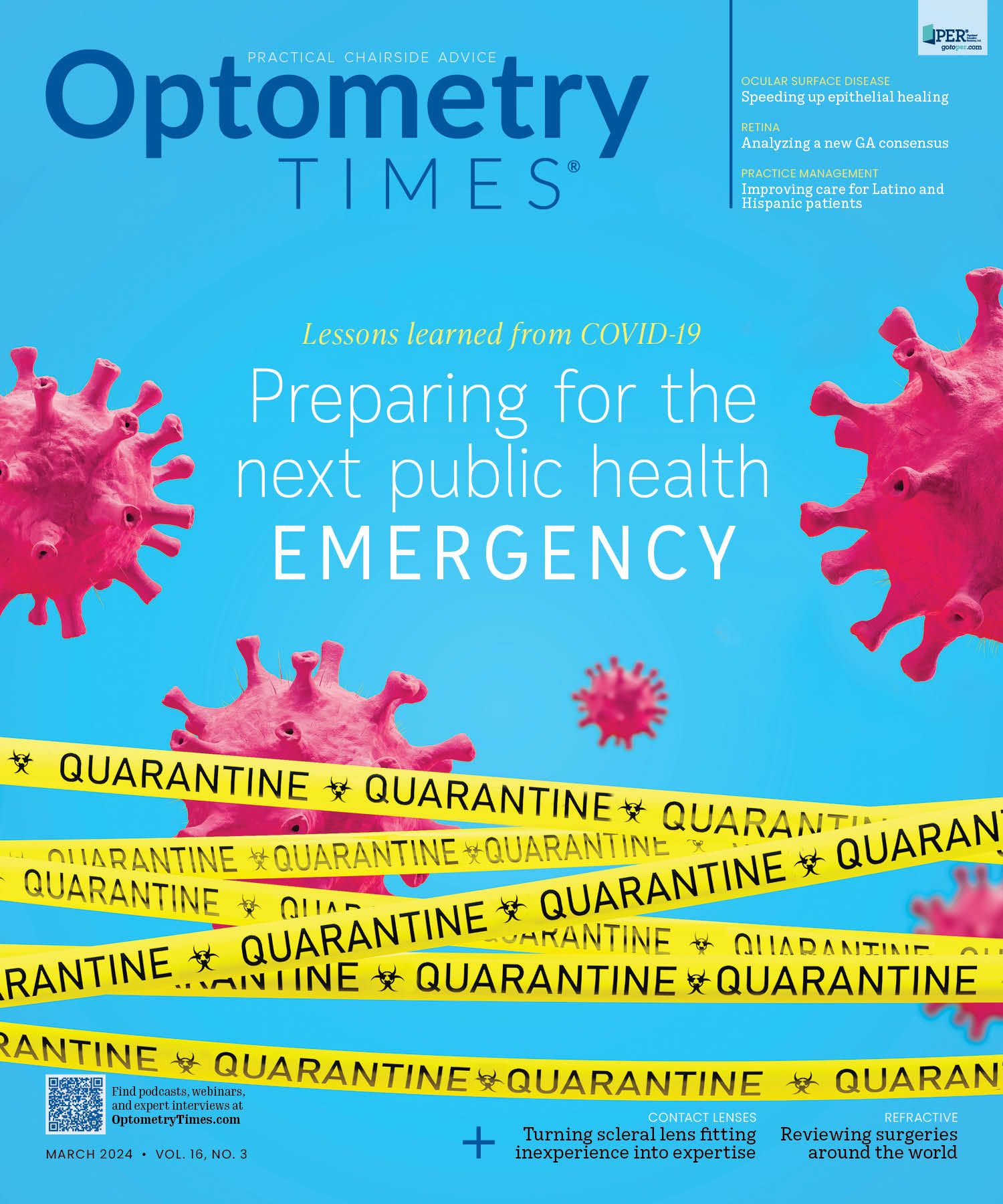- Therapeutic Cataract & Refractive
- Lens Technology
- Glasses
- Ptosis
- AMD
- COVID-19
- DME
- Ocular Surface Disease
- Optic Relief
- Geographic Atrophy
- Cornea
- Conjunctivitis
- LASIK
- Myopia
- Presbyopia
- Allergy
- Nutrition
- Pediatrics
- Retina
- Cataract
- Contact Lenses
- Lid and Lash
- Dry Eye
- Glaucoma
- Refractive Surgery
- Comanagement
- Blepharitis
- OCT
- Patient Care
- Diabetic Eye Disease
- Technology
Going global: Improving vision care for Latino and Hispanic patients
Bridging cultural and community gaps will provide quality eye care for all.
Image Credit: AdobeStock/NFelix/peopleimages.com

March 23, 2024, is designated as World Optometry Day. This presents an opportunity to appreciate expectations for and hurdles related to serving the rapidly-growing Hispanic and Latino populations in the United States.
As increasing numbers of immigrants enter the United States, the Hispanic and Latino populations continue to grow. In 2021, 44% of US immigrants—19.9 million people—reported having Hispanic or Latino ethnic origins.1 The US Hispanic population increased from 50.5 million individuals in 2010 to 63.6 million people in 2022, according to the Pew Research Center; people of Hispanic origin comprised 19% of people in the US that year compared with just 16% of the population in 2010 and just 5% in 1970.2 Overall, Hispanic people accounted for more than half of the total US population growth between 2010 and 2022.2 The 26% increase in the Hispanic population reported in 2022 occurred more quickly than did the rise in the nation’s growth rate (8%) but more slowly than did the expansion of the Asian population (34%).
Differentiating Hispanic from Latino
The terms Hispanic and Latino often are used interchangeably, but they have distinct meanings and implications. Hispanic refers to people who have a cultural or linguistic connection to Spain or, more broadly, to the Spanish-speaking countries of Latin America; the term primarily is tied to the Spanish language. They also can include people from various racial and ethnic backgrounds, as the term is more about linguistic and cultural ties than specific racial or ethnic identifiers.
On the other hand, Latino refers to people with cultural or ancestral ties to Latin America. This term is more inclusive, because it includes people from Latin American countries regardless of the predominant language spoken in their country. Latino individuals can be from any Latin American country, including nations where languages other than Spanish are spoken (eg, Brazil, where Portuguese is the primary language). The term Latino is often associated with cultural heritage rather than a specific language.
Importantly, these terms are not mutually exclusive, and communities may use them based on personal preference. Ethnicity, race, and nationality can further complicate use of these terms. The choice between Hispanic and Latino is subjective, and individuals may identify more strongly with either of these terms based on personal and cultural factors.
In practice, many people and organizations recognize the diversity of these communities and still use the terms Hispanic and Latino interchangeably. Still, it is always advisable to respect individual preferences when using these terms. With that in mind, the Hispanic or Latino population is referred to as the Hispanic population throughout this article.
Why is caring for the Hispanic population’s eye health and vision important?
With the ongoing growth of the Hispanic population, it is crucial to consider the nuances of eye care required when treating Hispanic patients. Taking care of eye health and vision contributes to public health goals, addresses disparities in health care, and fosters a healthier and more productive community.
Certain eye conditions (eg, diabetic retinopathy, glaucoma) are more prevalent among Hispanic populations,3 and regular eye care is essential to detect and manage these conditions promptly. For example, Hispanic individuals have higher rates of diabetes than do people of other ethnicities. This metabolic disease can lead to diabetic retinopathy, a serious eye condition that can result in vision loss. Proper eye care is essential for monitoring and managing diabetes-related eye issues.3
Good vision is integral to daily activities, education, and employment. Regular eye check-ups allow for early detection of issues, enable timely intervention, and prevent the progression of potentially serious eye conditions.3 Addressing and maintaining eye health within the Hispanic population contributes to improved quality of life. Some members of the Hispanic community, however, may face barriers to accessing eye care and other areas of health care. Promoting eye health helps to ensure equitable access to services and to reduce disparities in vision care.
Preparing eye care professionals to better serve the Hispanic population
Helping members of the Hispanic community with eye health and vision care involves several factors that include education, accessibility, and cultural considerations. The following steps can help address these factors.
Make education and outreach integral to the practice.Organize workshops or seminars, preferably offered in Spanish, to educate the Hispanic community about the importance of eye health, regular eye examinations, and preventive measures. If staff is not fluent in Spanish, consider hiring an hourly translator to help, and ensure that the translation is accurate. Distribute brochures, flyers, and other educational materials in Spanish to prevent language from becoming a barrier to the understanding eye health information. Materials about eye health, vision care, and upcoming events may also be shared on social media platforms. Tailor your content to be culturally sensitive, relevant, and (ideally) written in Spanish.
Collaborate with local organizations.Reach out to local Hispanic community centers, churches, or organizations to reach a wider audience. Further, participate in or organize health fairs that provide free or low-cost eye screenings and information on eye health.
Provide accessible eye care. Advocate for affordable eye care services or partner with eye care professionals who are willing to provide discounted services for the community. Consider organizing mobile eye clinics that can reach remote or underserved areas within the Hispanic community.
Promote cultural sensitivity. Awareness of cultural beliefs and practices related to eye health within the Hispanic community can help in tailoring a clinical approach and, accordingly, recommendations for patients. When organizing events or providing services, respect cultural norms and preferences to create a comfortable environment. In addition, recruit bilingual volunteers from the community or health care professionals who are willing to donate time to provide eye screenings or patient education. For those looking for an opportunity to volunteer, Vosh International needs help running its global optometric clinic program, which visits many Latin American countries year-round.
Bridging the gap with the Spanish language
Effective communication is fundamental to providing quality health care, and language proficiency is vital for achieving this goal. Health care providers who speak Spanish can contribute to improved patient outcomes, increased patient satisfaction, and a greater inclusivity of the health care environment for Hispanic patients. Eye care providers who provide bilingual health care supply many benefits to the community.
Improvement in communication. Language barriers can be a significant obstacle to effective communication in health care. Eye care providers who speak Spanish facilitate clear and direct communication with Hispanic patients, ensuring that important information about eye health, treatment options, and preventive measures is conveyed accurately.
Enhancement of understanding. Language is tied to cultural nuances and understanding. Spanish-speaking eye care providers may be better equipped to understand the cultural context of their Hispanic patients. This understanding can help address cultural preferences, beliefs, and concerns related to eye care and lead to more personalized and effective treatment plans.
Increase in trust and comfort. Patients often feel more comfortable and trusting when communicating in their preferred language. This is particularly true for individuals whose primary language is Spanish. Eye care providers who speak Spanish can create a more welcoming and patient-centered environment, fostering a positive doctor-patient relationship.
Collection of accurate medical history and information.Gathering of accurate medical history is crucial for effective eye care. As language barriers are reduced, Spanish-speaking eye care providers can obtain a more comprehensive medical history from Hispanic patients, leading to more accurate diagnoses and treatment plans.
Promotion of better compliance and follow-up. Understanding treatment instructions and recommendations is essential for patient compliance. Eye care providers who speak Spanish can ensure that Hispanic patients fully comprehend their treatment plans, prescription instructions, and follow-up care, which contributes to better adherence and improved health outcomes.
Additional resources
To help your Hispanic patients with both digital and hard copy resources, download outreach materials in Spanish from the National Eye Institute. Their library contains hundreds of materials that can be searched for information about eye diseases and conditions. (These materials are not copyrighted, and they can be downloaded, printed, and distributed freely.)
The American Academy of Ophthalmology has launched Salud Ocular, a Spanish-language version of its EyeSmart website, to empower Hispanic patients with the most trusted and accurate eye health information on the web.
Join a nonprofit organization, such as Latinos en Optometry, that can bridge the gap between Hispanic patients and eye care providers. This organization helps eye care professionals deliver eye health care in a culturally mindful manner through ongoing education and resources. Membership for optometry students is free.
By combining education, accessibility, online resources, cultural sensitivity, and collaboration, significant improvements in eye health and vision care can enhance quality of life within the Hispanic community.
References:
Ward N, Batalova J. Frequently requested statistics on immigrants and immigration in the United States. Migration Policy Institute. March 14, 2023. Accessed February 1, 2024. https://www.migrationpolicy.org/article/frequently-requested-statistics-immigrants-and-immigration-united-states
Manuel Krogstad J, Passel JS, Moslimani M, Noe-Bustamante L. Key facts about US Latinos for National Hispanic Heritage Month. Pew Research Center. September 22, 2023. Accessed February 1, 2024. https://www.pewresearch.org/short-reads/2023/09/22/key-facts-about-us-latinos-for-national-hispanic-heritage-month
Hispanics and Latinos have higher risk for vision loss. Division of Diabetes Translation, National Center for Chronic Disease Prevention and Health Promotion. Centers for Disease Control and Prevention. Reviewed December 19, 2022. Accessed February 1, 2024. https://www.cdc.gov/visionhealth/resources/features/hispanic-latino-vision-health.html

